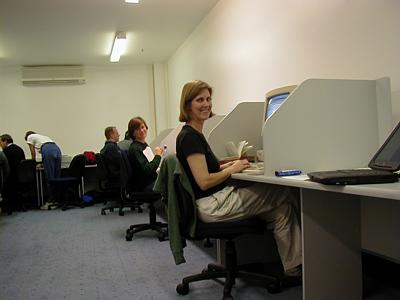4 November, 1999
Christchurch New Zealand Thursday
Deployment Day 4
5:00 a.m. Don from the Windsor pokes his head into our room and tells us to
go back to sleep. Deployment has been delayed until 9:15 a.m.
9:45 a.m. Arrive at the Clothing Distribution Center (CDC) and are advised
NOT to dress for the trip. We are asked to wait for a briefing at 10:00
a.m.
10:00 a.m. The worst (for us) is confirmed. We are placed on a 24 hour
hold (again). We leave with very long, sad faces!
This is what the life of a scientist is like whether she works in the field
or works in the laboratory. Very often, the scientist is waiting for
something. In our situation, we are waiting for the weather to clear and
the transport to be in top working condition. In the lab, scientists wait
for equipment to warm up, to work properly, to analyze results, and to cool
down. Often you wait for materials to thaw, to boil, or even to arrive at
your lab in time for a special experiment. Microbiologists wait for their
bacteria or tissue cultures to grow! The field scientist waits for the
proper conditions for conducting an experiment or collecting specimens.
Scientists are very patient people! And, as difficult as it is, we must be
patient as we wait to leave Christchurch and get to Antarctica.
Unfortunately, the field season in Antarctica is short and so the time in
which we have to complete our work is very limited. With every day that
passes, we lose precious time to collect samples and analyze them in the
lab. We must be very organized when we arrive so that we can get right to
work.
Answer to yesterday's question: The crew of the C-141 was correct in their
concern about the heating element for the jet's windshield. If the
windshield is not heated, at high altitude, the windshield could have
cracked and been blown out of the aircraft. Evidence of a problem was
probably clear when the captain began pressurizing the cabin and defrosting
the windshield. The cabin of the aircraft is pressurized so that passengers
and crew are comfortable and able to breathe with ease. At higher
altitudes, the pressure outside the aircraft decreases. Without proper
heating of the windshield, this difference in pressure would have caused the
windshield to explode as the jet climbed to it's cruising altitude. This
problem is probably far more complicated than I have indicated but, at least
you have a basic understanding of why it was necessary for us to be delayed
on Deployment Day 3!
Today's question: What is the Antarctic Convergence?
Sharon
JUST FOR KIDS!!!!! You are quickly learning what the life of a scientist is
like! Scientists must be patient while waiting for many things. Today, we
must wait for the weather in Antarctica to change before we leave New
Zealand! Again, the weather in Antarctica makes it difficult to land an
airplane there!
In what other ways must scientists be patient? Scientists wait for their
machines in the lab to warm up and cool down. We wait for bacteria to grow.
Field scientists, those scientists that work outside, must wait for the
weather to be just right for their experiments. We wait for materials to
thaw out when frozen, to boil, and to freeze. Scientists must be very
patient people!
Answer to yesterday's question: The crew of the C-141 were very careful.
They realized that if the heating system of the windshield did not work, the
windshield could explode when we reached a high altitude. The pressure
inside the airplane is greater than the pressure outside the airplane. If
the windshield was too cold, it would crack and explode. This would have
created a deadly situation. They have put in a new windshield on the C-141.
I am glad that they noticed this problem and fixed the windshield!
Today's question: What is the Antarctic Convergence?
Sharon

Working in the computer center at the International Antarctic Centre. While in Christchurch, this is where email is answered and journals are written. <>
Contact the TEA in the field at
.
If you cannot connect through your browser, copy the
TEA's e-mail address in the "To:" line of
your favorite e-mail package.
|
